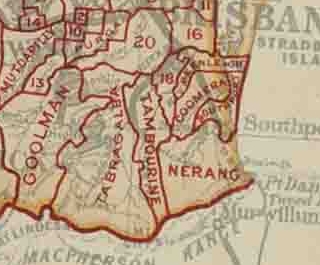1915 to 1942


When local grazier Robert Collins first learned of the declaration of the world’s first national park, Yellowstone in the United States of America in 1872, he began to dream in 1878 about the conservation of the grand forests of the McPherson Ranges (including Canungra and Pine Creek Valley of Coomera) for establishment of a National Park. Ironically, as son of the Canungra Sawmill family, Romeo Lahey joined the campaign in 1911 and continued the struggle after Robert Collins died in 1913.
Romeo Lahey wrote letters to the Shire Councils of Tambourine and Beaudesert and then Premier Hon. DF Denham emphasising “the economic and national importance of leaving scrub in rough country”. He wrote: ‘I implore you in the name of, and for the sake of generations yet unborn, to vote for the immediate and total reservation of that area.’ (Extract 25 June 1913.) The Tambourine Shire Council supported the whole area becoming a national park while the Beaudesert Council was agreeable to 400 hectares being set aside for the park. It was not until the Labor Government was elected in 1915 that the Lamington National Park was finally declared.
In 1920, the Canungra Mill was purchased by the Commonwealth War Service Homes Department, and Lahey’s Tramway that serviced the Canungra Station carrying timber from the Lamington Range to the Canungra Mill, began to close. The Commercial Bank of Australia established a branch in Canungra in the early 1920s.
The Tambourine Hall Committee formed in 1920 and at the first official meeting it was proposed to build a new hall in order to accommodate the many dances and activities. The hall’s first bank account was opened in March 1921, and in May 1929, the Tambourine Hall was handed over to the people of Tamborine free of debt for their use. The first Ladies Committee was also officially formed in 1929 to include Mrs EP Walsh, Mrs A Massie, Miss K Siganto and Miss Knight.
On 29 April 1926, the spelling of the Tambourine State School was changed to Tamborine. This happened, apparently, due to the spelling being changed to ‘Tamborine’ in a letter from the Department of Public Instruction to the Department of Public Works. In 1927, the Bellissima Guest House was sold and became the Canungra Hotel. As well, on Saturday April 9 1927, at 10.20am, the Duke and Duchess of York left South Brisbane Railway Station for Beaudesert, where they attended the Beaudesert show, and stayed at Tamrookum, a private country residence.
From 1930 to 1931, the Hancock Brothers established a plywood mill in North Ipswich and became one of Australia’s largest plywood producers (this will later become significant). On Monday 19 March 1934, twenty-one applications were received for the position of clerk of the Tamborine Shire Council, rendered vacant by the resignation of Mr James Dunn, after 32 years unbroken service.
In the 1930s, the third Tambourine Hotel burnt down in a suspicious fire after the lease was not to be renewed. The Dean family took over ownership of the Tambourine Post Office and General Store in 1936. The Canungra Hotel was also destroyed by fire in 1937.
In 1939, ‘Tambourine’ was officially renamed to ‘Tamborine’, becoming the ‘Tamborine Shire Council’. As well, the railway service was also reduced – apparently to two trains per week with many of the sidings being removed.
In 1940, the Tamborine Hall was damaged by a storm that left the church next door untouched. From 1940 to 1941, preparations were made to pull down the hall and re-erect it on the new site (currently where Rural Fire Station is located). On 26 April 1941, the new Hall was officially opened and renamed to Tamborine Memorial Hall.
At a Tamborine Shire Council meeting on 10 November 1941 it was decided by seven votes to three in favour of removing the Shire Office from Tamborine to Canungra. Clr. Geissmann asked that the notice be rescinded but was not accepted. In July 1942, during World War II, the 32nd Infantry Division of the American Army established a jungle warfare training camp in the Yarrabilba area called Camp Tamborine, creating the busiest period for traffic on the railway line. In 1942, the Australian Defence Canteen Service took possession of the Hall and was used as a major storage facility.
